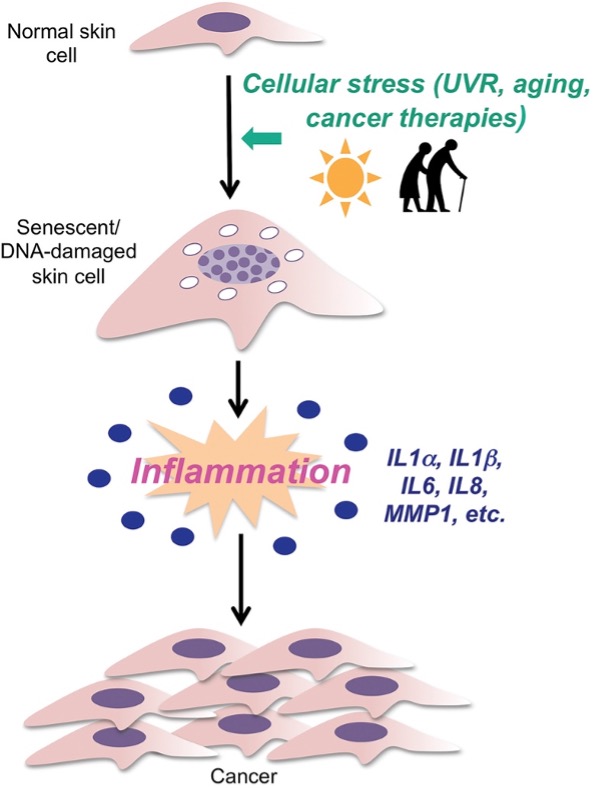Key Points:
- Senescent cells secrete molecules that promote chronic inflammation and organ deterioration, contributing to chronic diseases and aging.
- Senescent cells may accumulate with aging because the immune system can’t keep up with clearing them out.
- With more funding for additional research, therapies targeting pro-aging senescent cells may be developed in the future.
Whether from DNA damage, infection, or other stressors, our cells can enter a state of growth arrest called senescence. Senescent cells tend to accumulate with age and are associated with multiple diseases and disorders, making them a prime target for anti-aging compounds.
Still, not all senescent cells contribute to aging and disease. Of the senescent cells that secrete molecules known as SASP factors, only 30-70% may contribute to aging. The other 30-70% may be beneficial, with some contributing to tissue repair and healing. Additionally, senescence may prevent the spread of cancer by halting the growth of cancer cells.
How Senescent Cells Contribute to Aging
Aging can be described as the gradual deterioration of organs and tissues, leading to physiological impairments that foster chronic diseases and increased vulnerability to death. Scientists have tentatively identified twelve overlapping factors that contribute to this gradual deterioration, referred to as the hallmarks of aging, which include senescent cells and inflammation.
As such, senescent cells and inflammation underlie many age-related diseases, including cancer, cardiovascular disease, Alzheimer’s disease, and type 2 diabetes, which top the United States’ leading causes of death. Additionally, senescent cells and the inflammation they promote by secreting pro-inflammatory SASP factors, are associated with age-related muscle (sarcopenia) and bone weakness (osteoporosis), among other diseases and conditions.

Furthermore, when cells transition to a senescent state, they can become dysfunctional, which is a particular problem for stem cells. For example, when our muscles are damaged from resistance exercise, muscle stem cells help repair muscle tissue, and contribute to muscle hypertrophy. However, when muscle stem cells become senescent, they are unable to regenerate muscle tissue, which is one of the reasons why they are associated with sarcopenia.
Why Do Senescent Cells Accumulate with Age?
Typically, the inflammation created by senescent cells is enough to alert our immune system to remove senescent cells within a few days or weeks. However, according to the threshold theory of senescent cell accumulation, once the abundance of senescent cells reaches a specific threshold, the immune system can no longer keep up with removing them. In turn, even immune system cells become senescent, which further exacerbates senescent cell accumulation.
Threshold theory is based on studies showing that transplanting senescent cells into mice with high senescent cell levels, such as middle-aged and obese mice, leads to age acceleration. Similarly, children who have undergone anti-cancer therapy, which damages DNA and triggers senescence, tend to age faster than normal.

It is also possible that senescent cells accumulate with age because our immune system tends to become less efficient with age. This leads to reduced clearance of senescent cells by our immune system, allowing senescent cells to accumulate. However, whether pro-aging senescent cell accumulation occurs before or after age-related immune system decline remains unclear and both scenarios may occur simultaneously.
Targeting Pro-Aging Senescent Cells
One way to potentially reverse senescent cell accumulation and mitigate aging and disease is with senolytic intervention. Senolytics are compounds that selectively target and eliminate senescent cells. However, as mentioned above, not all senescent cells contribute to aging and diseases. Some senescent cells, such as those in the brain and heart even maintain partial functionality. Therefore, it seems necessary to develop senolytics that target only pro-aging senescent cells.
At the 2023 Seno-Therapeutics Summit, hosted by the Buck Institute in California, longevity experts convened to discuss the development of drugs targeting senescent cells. In an editorial emphasizing the focal point of the summit, recently published NPJ Aging, the authors concluded,
“The summit underscored the importance of embracing diversity in senescent cell populations, and highlighted the potential for developing targeted treatments against age-related diseases.
In the coming years, it will be important to stimulate more investments in the field from governmental and non-profit agencies, but also from venture firms and large pharmaceutical companies.”
Therefore, with enough investment and further research, we may see therapies specifically targeting pro-aging senescent cells in the future.